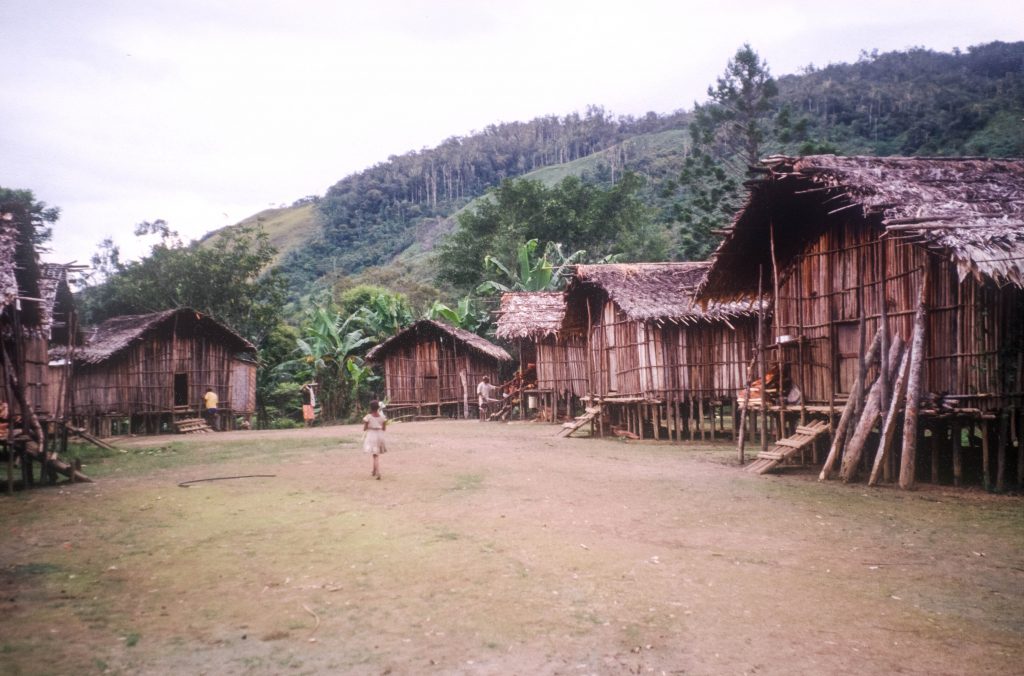The Mysterious Power of Arrogance

Urapmin, a remote community in the mountains of Papua New Guinea, is not connected to any other place by road, and there is no electricity in any of its seven villages. The people there, also called Urapmin, have no regular way of earning cash. They build their houses out of materials they gather from the rainforest that surrounds them, and they garden and hunt for their food. In the early 1990s, I spent two years living and doing ethnographic fieldwork in Urapmin. It’s the kind of place most people would only encounter in the pages of National Geographic, and it’s hard to imagine a society more different from the modern United States. Nonetheless, I’ve found myself thinking a lot about Urapmin since the U.S. presidential election.
When I lived in Urapmin, the community had a population of about 400 people, and only a few of them counted as what one might call local “celebrities”—household names that people talked about a lot. One of them was a singular character named Kinimnok (a pseudonym). He frequently boasted, was loud, and was prone to angry outbursts. Most Urapmin tend to keep their successes to themselves, are quiet, and never openly express anger for fear it might make others sick. His manner, then, was quite un-Urapmin.
It was more than Kinimnok’s manner, however, that made him stand out. Urapmin obtain almost all their food from their gardens, which are tended by both men and women. Gardening is hard work and not very glamorous, but the rewards are steady. If you put most of your energy into gardening, you are unlikely to go hungry. Men also hunt for marsupials in the jungle at night using bows and arrows. Hunting is spectacularly unreliable—most trips to the bush net nothing. But if a hunter does succeed, it’s a big deal. Urapmin rarely get the opportunity to eat meat, so when a hunter distributes his kill, his prestige goes way up.
Since being a successful hunter can greatly enhance a man’s reputation, the temptation for men to favor hunting over gardening is high, and Urapmin folktales regularly depict the bad ends that come to men who hunt to the extreme. In these tortoise-and-hare-type stories, the cautious gardener always comes out ahead of the flashy hunter. And just in case the message of the tales is not clear, Urapmin also believe that men who have a run of luck in hunting have unknowingly married the female spirit who looks after the marsupials. She first makes her new husband successful in the hunt, Urapmin say, but she soon after will become jealous of his human wife, and eventually she will try to kill him. The first time a recently successful hunter comes close to having an accident while hunting in the forest, he assumes the marsupial spirit is ready to be done with him, and he stops hunting for a while.
Kinimnok was a very successful hunter. He hunted all the time, neglected his gardens, which sometimes failed, and frequently proclaimed—clutching his chest in pain—that the marsupial spirit (whom he said he had long been married to) was constantly trying to kill him. No other Urapmin man behaved like this.
And finally, while it is allowable for Urapmin men to have more than one wife—which increases the amount of labor available to a household and allows a man to host more generous feasts and increase his fame in the community—Kinimnok was the only man who was married to two women. The fact that his younger wife was the daughter of his older one, and that he had raised her as his own child since infancy, only further increased people’s sense that Kinimnok was a strange character who often strayed beyond what most Urapmin considered acceptable boundaries.
During my first year in Urapmin, I found Kinimnok overbearing and obnoxious, and I assumed that others did too. After all, they often talked about him in mildly judgmental tones. But then he threatened to kill the man the Urapmin had elected to represent them to outsiders. Many people began to fear that the government, a very distant power, would hear about this threat and jail Kinimnok somewhere far away. Although everyone agreed Kinimnok’s threat was outrageous, they were still greatly saddened at the prospect of him being removed from the community.
I was stunned by this outpouring of sorrow over Kinimnok’s possible removal from the community, and I quickly had to re-evaluate my understanding of what he meant to people. I recalled that although none of the seven villages in Urapmin would let Kinimnok live within their boundaries—his unpredictable anger was too threatening—members of the village nearest to his lonely homestead had in fact elected him as their representative to the wider Urapmin community. I also began asking people who their “favorite” Urapmin person was, and to my surprise, the name people gave me most frequently was his. He is so funny, they said, and he often has game to give away. Kinimnok, this person who at one time or another scandalized pretty much everyone, turned out to be one of the most popular people in the community. But there had to be more to his appeal than just his humor and his hunting prowess.
In the years since I left Urapmin, I have from time to time tried to figure out why Kinimnok was so popular among his people. Recently, after the U.S. presidential election, I think I may have finally found the answer to this question.
Urapmin saw Kinimnok as a “willful” (futebemin) man. He did what he wanted without regard for others. Urapmin think it is sometimes important for people to be willful. This is so, they say, because people sometimes have to push others a bit hard to make new things like marriages, hunting parties, and gardening groups come to life. Willfulness, then, is a value for them. At the same time, though, Urapmin tend to think that a little willfulness goes a long way. So they also value an opposite quality they call “lawfulness” (awem)—a willingness to preserve things as they are, rather than to create something new, and to meet the social obligations one already has.
Most Urapmin spend their lives trying to find balance between willfulness and lawfulness, recognizing that their success in realizing one of these values is always a failure in realizing the other. Moving back and forth between their two values, most people never realize either one completely, but at the same time, they never fail to fulfill each of them in partial ways. I think Kinimnok captivated other Urapmin because he showed them what willfulness in its fullest form looks like. Most of them would never follow him in realizing willfulness so absolutely, but they appreciated the chance to see what this value looked like when it was given such elaborate expression.
In all societies, just as with the Urapmin, people have to balance values that are not fully compatible with one another. The values that come into conflict differ—in modern democracies some of the key opposed pairs are values like security and freedom, liberty and equality, and the self and the community—but the trick of balancing them remains much the same. Hence, people like Kinimnok, who give up on balance and put all their efforts into achieving a single value, always stand out from the rest, and they often seem to captivate their fellows.
A certain kind of rugged, me-and-mine-first individualism has long been a value in the United States, but it has competed with other values that are concerned with openness, tolerance, and the common good. People usually balance these, compromising on all of them in order to realize a little bit of each. But perhaps because the value of individualism has become harder for most people to realize, even partially, in their current economic circumstances, many Americans recently proved captivated by someone with little interest in values other than individualistic self-promotion. They were joined to a candidate—who went on to become President Donald Trump—by a bond anchored in his ability to express this one value of theirs very fully.
Societies tend to work better when their members struggle to balance conflicting values, and this gives grounds to worry about what leadership devoted to a single value—particularly one such as self-promotion—might be like. Based on my experience in Papua New Guinea, I am not as surprised as I once would have been that many people in the U.S. found themselves attracted to someone who single-mindedly pursues one of their values at the expense of all the rest. But the Urapmin never put Kinimnok at the head of their government, allowing his willfulness to do away with the role of lawfulness in their lives. It remains to be seen how America’s other values will fare in the wake of an election that prioritized one value above the rest.
An adapted version of this article was republished on Aeon.


































